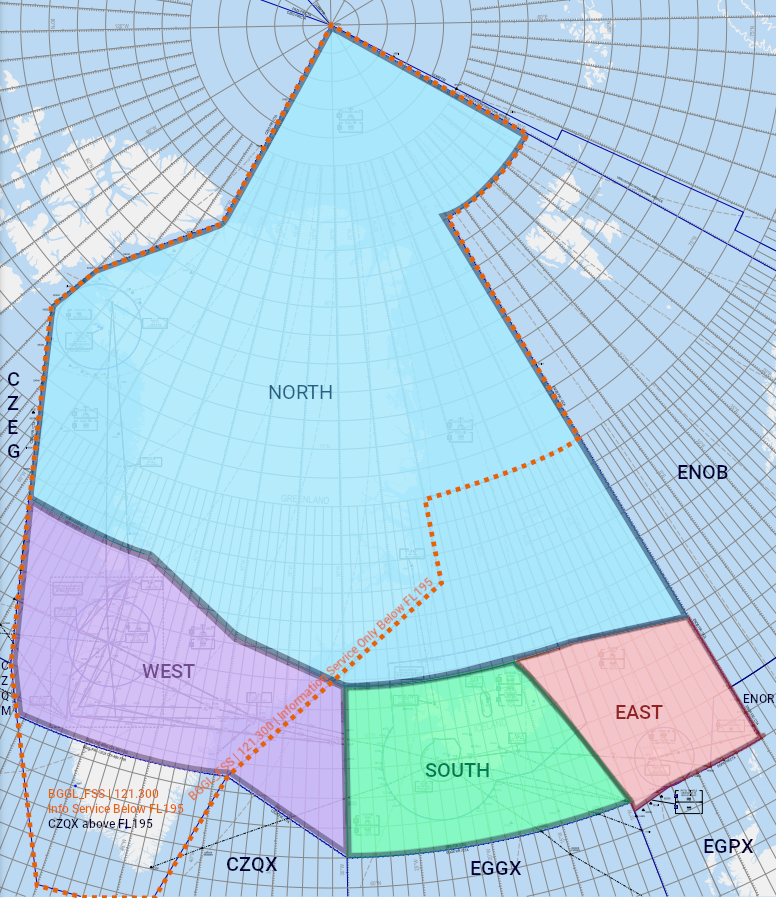General
Full List of ATS Positions
|
Coordination Name |
VATSIM Logon |
Radio Callsign |
Frequency |
|
South 1 (S1) |
BIRD_S1_CTR |
Reykjavik Control |
119.700 |
|
South 2 (S2) |
BIRD_S2_CTR |
125.700 |
|
|
South 3 (S3) |
BIRD_S3_CTR |
128.600 |
|
|
East 1 (E1) |
BIRD_E1_CTR |
126.750 |
|
|
East 2 (E2) |
BIRD_E2_CTR |
132.200 |
|
|
East 3 (E3) |
BIRD_E3_CTR |
128.800 |
|
|
West 1 (W1) |
BIRD_W1_CTR |
124.400 |
|
|
West 2 (W2) |
BIRD_W2_CTR |
127.500 |
|
|
West 3 (W3) |
BIRD_W3_CTR |
128.200 |
|
|
North 1 (N1) (EVENT ONLY) |
BIRD_N1_CTR |
133.100 |
|
|
Radio 1 (CC1) |
BICC_1_FSS |
Iceland Radio |
127.850 |
|
Radio 2 (CC2) |
BICC_2_FSS |
126.550 |
|
|
Radio 3 (CC3) (EVENT ONLY) |
BICC_3_FSS |
129.625 |
Login Priority
Reykjavik Control (BIRD_**_CTR)
South 1 (BIRD_S1_CTR) may be opened at any time. All other BIRD positions may only be opened after South 1 has been opened (except if South 2 and South 3 are being opened at the same time.)
Iceland Radio (BICC_*_FSS)
Radio 1 (BICC_1_FSS) may be opened at any time. All other BICC positions may only be opened after Radio 1 has been opened. See the Iceland Radio page for more information.
Sectorization
The Reykjavik CTA is divided into four lateral sectors: North, South, East, and West.
Bandboxing
The South sector positions (S1 / S2 / S3) bandbox the East & West sectors when no controllers are online for those sectors.
Dynamic Vertical Splits
Each sector may be dynamically split up vertically to three times to increase traffic capacity, following these rules:
- When two sector splits numbered 1 & 2 are online, they shall split the sector at FL345 (split 1 is lower, 2 is higher.)
- When two sector splits numbered 1 & 3 are online, they shall split the sector at FL355.
- When two sector splits numbered 2 & 3 are online, they shall split the sector at FL365.
- When three sector splits (1, 2, and 3) are online, sector no. 1 covers up to FL345, sector no. 2 from FL345-FL365, and sector no. 3 from FL365+.
Bandboxed Splits
If there are multiple South sectors online, but no East or West sectors are online, the South positions will split the South, East, and West sectors at the same level.
- For example, if South 1 and South 3 are both online, then they would bandbox and split the South, East, and West sectors at FL355.
- However, if any controller were then to come online for the East or West sectors, they would take over that entire sector, top to bottom.
Top-Down
In general, whichever Reykjavik Control position covers the lowest vertical levels also covers all local (aerodrome, approach, etc.) positions in that sector top-down. For specific aerodrome top-down coverage for each respective sector, see their individual pages.
Oceanic Clearance
All aircraft entering Reykjavik OCA require oceanic clearance (OCL).
Aircraft entering Reykjavik OCA without having previously obtained OCL should request clearance, as a rule of thumb, 20-25 mins prior to oceanic entry. Clearance may not be granted earlier than X mins from entry, for aircraft entering from the following domestic airspace:
- From Stavanger ACC (Polaris FIR) & Scottish: No earlier than 25 mins
- From Murmansk: No earlier than 30 mins
- From Edmonton: No earlier than 45 mins
In general, airborne aircraft inbound to Reykjavik OCA shall be provided OCL from Iceland Radio if online, or from an appropriate Reykjavik Control sector if Iceland Radio is offline. Aircraft departing from AFIS aerodromes shall be issued a combined IFR/oceanic clearance by the overlying Reykjavik Control sector, to be relayed via the local AFIS unit.
If, for any reason, an aircraft has not received OCL prior to entry into Reykjavik OCA, they shall continue flying via their filed route & previously cleared flight level until otherwise cleared.
The Reykjavik sector which they are presently in should issue them a clearance ASAP.
When Iceland Radio is online, generally speaking:
- Domestic ATC will transfer aircraft to Iceland Radio prior to oceanic entry (transfer of communications, as well as releasing the tag).
- Iceland Radio shall provide OCL, after which the aircraft returns to domestic ATC.
- Domestic ATC will then transfer the aircraft to the appropriate Reykjavik Control sector at the usual transfer of control point.
When Reykjavik Control is online without Iceland Radio, Reykjavik Control may simply provide aircraft OCL upon the normal point of first contact.
- If neighboring domestic ATC is offline, Reykjavik Control may send a .contactme 5-10 mins from entry into the Reykjavik OCA (if the pilot has not yet contacted Reykjavik on their own)
- If neighboring domestic ATC is online, they will simply transfer the aircraft to Reykjavik at the normal Transfer of Communication point (as specified in LOAs).
- In both cases, the aircraft stays on Reykjavik’s frequency after obtaining OCL, through to entering Reykjavik’s airspace.
Example RT between Reykavik and the pilot
ATC: "Iceair123, Report estimated time over VALDI, Your requested flight level andmatchmach number."
ICE123: "Iceair123, Estimating VALDI at 1123 zulu, Requesting FL370, Mach .83"
ATC: "Iceair 123, Roger Maintain mach .83"
NOTE: ATC can at any time change altitude and speed assignments, aircraft still need clearance to clime and descend.

